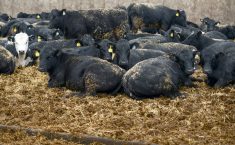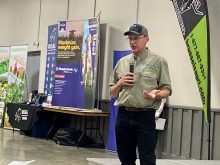Despite recent changes that allow veal carcasses to weigh 10 kilograms more than previously, producers were recently advised not to set the heaviest limit as the goal for all calves.
During a morning session at the Veal Farmers of Ontario annual general meeting, the organization’s executive director Jennifer Haley impressed upon producers the importance of using the extra 10 kg to manage their feeding and shipping decisions. They shouldn’t take it as a signal to aim for the heaviest possible animal still qualifying for a per-kilogram price for veal.
Read Also

Ontario’s agri-food sector sets sights on future with Agri-Food 2050 initiative
The first-ever Agri Food 2050, a one-day industry event dedicated to envisioning the future of food and farming in Ontario,…
“Your target weight should stay the same (as it was under the 180-kg limit), but this will make it easier to manage,” the executive director said. “If people change their target weight, we haven’t solved the problem.”
“We don’t want to see 500-pound carcasses labelled as veal. That’s certainly not the intent of this change.”
Why it matters: Overweight carcasses shipped into the veal market must be marketed as ungraded beef, reducing returns for processors and producers.
Amendments came into force earlier this year allowing for an increase to 190 kg from 180 kg in the maximum weight for a carcass to still qualify as veal in Canada.
At the recent VFO meeting, Alex Fontaine, president of Montreal-based Montpak International, North America’s largest veal processing company, said he expects the new limit to be more strictly enforced than in previous years
“People will optimize their business. We accept that,” he said, adding that it was very important for producers to stay within the veal definition.
The change was made possible by the adoption in 2019 of the new Safe Food For Canadians Act, which eliminated the Livestock and Poultry Carcass Grading Regulations, and instead allowed for guidance in matters related to beef, bison and veal from the Canadian Beef Grading Agency.
Under the new legislation, future amendments to meat grading standards can be updated more quickly and without changes to the regulation itself. The carcass weight change, the first since 2001 for Canadian veal, was the first grading change to be considered under the Act’s updated regime.
Haley, also the executive director of the Canadian Veal Association (CVA), said overweight carcasses “had become an issue throughout the entire supply chain.”
“Veal carcasses that go over the weight limit… often mean that both the producer and the processor are forced to sell at a discount.”
Fontaine agreed and added that veal consumers are frequently well-informed and aware of the texture and flavour of meat they want. Add to that the increasing scrutiny by animal welfare advocates, and the veal sector will need to continue its efforts to be transparent.
Fontaine and his two brothers own the largest veal and lamb processing business in North America. It all began — and continues to unfold — on the family’s farm near St-Hyacinthe. Their father sold the dairy cows in 1976 and went into cash crops but in 1980, the Ecolait company came into Quebec and the Fontaines were the first family to sign on and begin producing for the company’s veal program.
Little did they know at the time the family’s expanded food processing venture — started in 1989 by Alex’s older brother Fabian — would eventually purchase Ecolait’s assets in 2017. In between, the family’s other acquisitions included Catelli Bros. in 2009, and Montpak in 2015.















